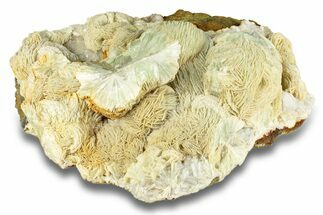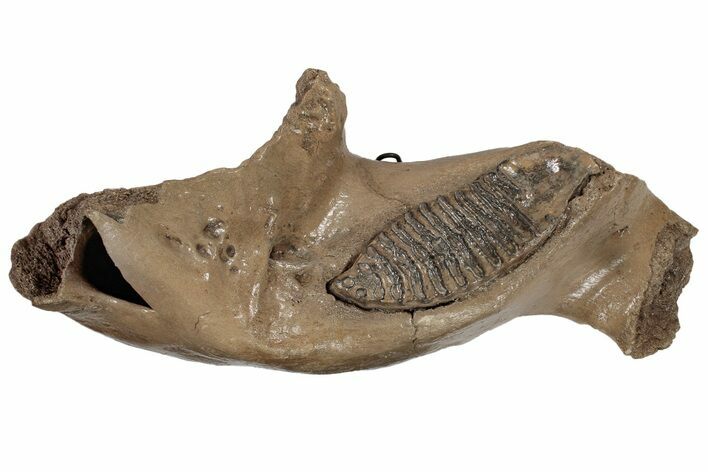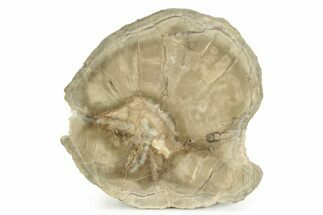This Specimen has been sold.
Massive, 25.5" Woolly Mammoth Mandible with M3 Molar - North Sea
This is a massive, 25.5" long mandible (lower jaw) half of a woolly mammoth, complete with a beautifully preserved M3 molars still in place. It would have come from an adult mammoth and the molar measures 10.2" long by 3.4" wide. This mammoth fossil is truly a sight to behold!
It is in phenomenal condition with excellent bone and molar preservation, complete with exposed foramen along the distal-lateral side of the mandible. These foramen would have housed blood vessels and nerves. The bone is exceptionally stable and while it required the common conservation layer stabilizer, it has undergone no crack repair or restoration!
Comes with a metal display stand to assist with presentation.
It is in phenomenal condition with excellent bone and molar preservation, complete with exposed foramen along the distal-lateral side of the mandible. These foramen would have housed blood vessels and nerves. The bone is exceptionally stable and while it required the common conservation layer stabilizer, it has undergone no crack repair or restoration!
Comes with a metal display stand to assist with presentation.
About The Woolly Mammoth
The Woolly Mammoth (Mammuthus primegenius) is an iconic Pleistocene animal. It had long, wooly hair, tusks that extended up to 9 feet, and stood about 12 feet tall. They ranged across the northern hemisphere and were one of the most abundant Pleistocene creatures, ranging from eastern Eurasia throughout most of North America. Their existence overlapped with that of humans: early cave paintings have been discovered depicting these massive mammals, and humans likely hunted them to extinction in some areas.
They are also some of the most studied prehistoric animals in part because many carcasses have bene preserved in the Siberian permafrosts, keeping skin, muscle tissues, and even their distinctive woolly hair intact. Recent genomic sequencing of chromosomal DNA in some of these preserved specimens has revealed that Woolly Mammoths are most closely related to African elephants: their chromosomal DNA is up to 99.5 percent identical.
The Woolly Mammoth (Mammuthus primegenius) is an iconic Pleistocene animal. It had long, wooly hair, tusks that extended up to 9 feet, and stood about 12 feet tall. They ranged across the northern hemisphere and were one of the most abundant Pleistocene creatures, ranging from eastern Eurasia throughout most of North America. Their existence overlapped with that of humans: early cave paintings have been discovered depicting these massive mammals, and humans likely hunted them to extinction in some areas.
They are also some of the most studied prehistoric animals in part because many carcasses have bene preserved in the Siberian permafrosts, keeping skin, muscle tissues, and even their distinctive woolly hair intact. Recent genomic sequencing of chromosomal DNA in some of these preserved specimens has revealed that Woolly Mammoths are most closely related to African elephants: their chromosomal DNA is up to 99.5 percent identical.
These Pleistocene fossils were dredged up by fishing trawlers in the the North Sea between Britain and Denmark. Fishermen routinely find mammoth teeth and many Ice Age fossils in their nets: given the chance that a fossil is accidentally gathered in a net is slim, the sea floor is probably littered with the remains of millions of animals. The cold temperatures and low-oxygen environment of the North Sea have aided in the preservation of these teeth and bones.
While these fossils have been pulled up in nets for more than a century, they used to be frequently discarded. It wasn't until the past two decades that this material has begun to be systematically collected and studied. By recording the locations of their finds and allowing scientists to make observations before the more common material is made available, much has been learned about the fauna that once roamed the land that now lies 30 to 150 feet below the North Sea waters.
You can read more information about this at the following link.
http://www.independent.co.uk/news/science/the-watery-grave-of-europes-monsters-1744973.html
While these fossils have been pulled up in nets for more than a century, they used to be frequently discarded. It wasn't until the past two decades that this material has begun to be systematically collected and studied. By recording the locations of their finds and allowing scientists to make observations before the more common material is made available, much has been learned about the fauna that once roamed the land that now lies 30 to 150 feet below the North Sea waters.
You can read more information about this at the following link.
http://www.independent.co.uk/news/science/the-watery-grave-of-europes-monsters-1744973.html
These fossils have been submerged in salt water for over ten thousand years, so they had to go through a lengthy stabilization process so they do not disintegrate. The fossils are immersed for six weeks in constantly refreshed fresh water. They are then slowly dried and stabilized with a museum standard conservation layer, which not only preserves the fossils but also brings out their natural stunning coloring. This process takes around two to three months to complete.
SPECIES
Mammuthus primigenius
LOCATION
North Sea
FORMATION
North Sea Deposits
SIZE
Mandible: 25.5 x 12 x 8.6", Molar: 10.2 x 3.4"
CATEGORY
SUB CATEGORY
ITEM
#200829
We guarantee the authenticity of all of our specimens.
 Reviews
Reviews






















